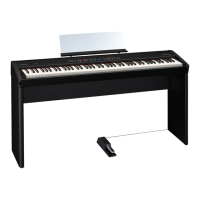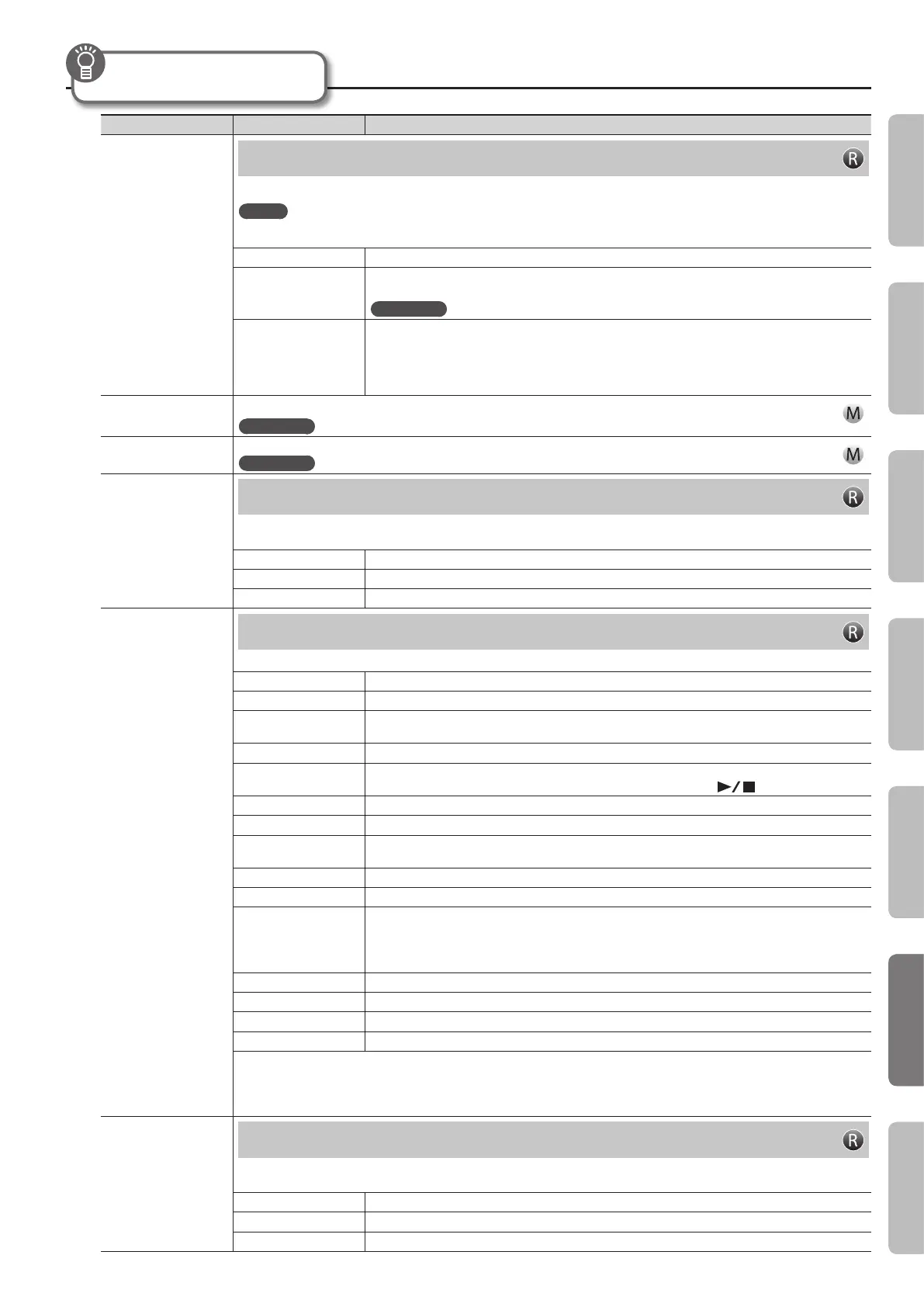Detailed Function Settings (Function Mode)
Parameter Value Explanation
SplOnRcg
(Split On Chord
Recognize)
Chord Recognition When Split Is On (Split-On Chord Recognition)
Sets how the FP-50 recognizes rhythm chords while Split Play is on.
MEMO
When Split Play is o, chords are recognized as follows.
While the damper pedal is not pressed, the FP-50 recognizes a chord when 3 or more keys are struck.
While the damper pedal is pressed, the FP-50 recognizes a chord when 1–5 keys are struck.
STD Normal chord recognition.
INT
Play chords even when basic chord tones are missing. Allows you to generate chords with very simple
keyboard playing.
REFERENCE
For details about chord ngering, see “Chord Fingering List” (p. 53).
EASY
Allows you to specify chords with very simple keyboard playing.
Major: Just play the chord root.
Minor: Play the root and a black key to the left of the root.
Seventh: Play the root and a white key to the left of the root.
Minor Seventh: Play the root and both a white key and a black key to the left of the root.
EQ Sw
(Equalizer Switch)
Turns the equalizer on and o.
REFERENCE
For details, refer to “Adjusting the Tone Color (Equalizer)” (p. 17).
EQ Edit
(Equalizer Edit)
Modies the tone color by boosting or attenuating dierent frequency ranges.
REFERENCE
For details, refer to “Adjusting the Tone Color (Equalizer)” (p. 17).
DPdl Prt
(Damper Pedal Part)
Changing How the Pedal Eects Are Applied (Damper Pedal Part)
When you press the pedal connected to the DAMPER/R jack during Dual Play or Split Play, the pedal eect is normally applied to both tones,
but you can also select the tone to which the eect is to be applied.
R+L All enabled
R Applied only to the Tone 1 (in Dual Play mode)/Right-hand Tone (in Split Play mode)
L Applied only to the Tone 2 (in Dual Play mode)/Left-hand Tone (in Split Play mode)
CPdl Fnc
(Center Pedal Function)
Changing the Function of the Center Pedal (Center Pedal Function)
Use this feature to change the function of the pedal connected to the SOSTENUTO/C jack.
SOST (Sostenuto) *1 Sets function to sostenuto pedal.
SOFT *2 Sets function to soft pedal.
EXPR (Expression) *3
Allows control of the volume. You may nd it convenient to connect an expression pedal (EV-5: sold separately).
Does not change the volume of rhythm play or recorded performance play.
M.EXP (Master Expression) Controls the overall volume of the FP-50.
ST.SP (Start/Stop)
When the [RHYTHM] button is lit: Starts and stops rhythm play (same function as the [START/STOP] button).
When the [SONG] button is lit: The pedal will have the same function as the [
] button.
IN.EN (Intro/Ending) *4 The pedal will have the same function as the [INTRO/ENDING] button.
VARI (Variation) *4 The pedal will have the same function as the [VARIATION] button.
RES.S
(Rhythm Reset/Start) *4
When you depress the pedal, the selected rhythm begins playing from the top.
This is convenient when you lose the beat or forget where you are in the song.
HOLD (Chord Hold) *4 Turns chord holding on and o.
FILL (Fill-In) *4 Inserts a ll-in.
L.BSS (Leading Bass)
Allows control of the on/o of leading bass function. It is turned on while the pedal is depressed.
What is the leading bass function?
The function that sounds the lowest note of a ngered chord as the bass tone is called “Leading Bass.”
* The Leading Bass feature is always on while Split is o.
B. UP (Bend Up) *3 Pitch rises when pedal is depressed.
B.DWN (Bend Down) *3 Pitch is lowered when pedal is depressed.
MOD (Modulation) *3 Vibrato is added when pedal is depressed.
RTSW (Rotary Sw) When using the rotary eect, switches the rotary eect between slow and fast.
*1 Only works on the Center Pedal Function.
*2 Only works on the Left Pedal Function.
*3 Works only on the tone set as the corresponding pedal part (CPdl Prt or LPdl Prt).
*4 Available when using a rhythm.
CPdl Prt
(Center Pedal Part)
Changing How the Pedal Eects Are Applied (Center Pedal Part)
When you press the pedal connected to the SOSTENUTO/C jack during Dual Play or Split Play, the pedal eect is normally applied to both
tones, but you can also select the tone to which the eect is to be applied.
R+L All enabled
R Applied only to the Tone 1 (in Dual Play mode)/Right-hand Tone (in Split Play mode)
L Applied only to the Tone 2 (in Dual Play mode)/Left-hand Tone (in Split Play mode)
For details about how to make function
mode settings, see p. 37.
39
Operation Guide Getting Ready Performing Recording Registrations Settings
Appendix

